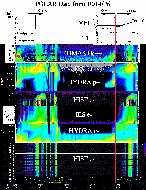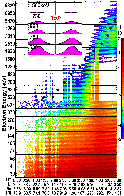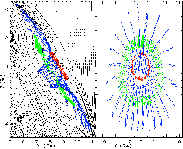
The Discovery of Trapped Energetic Electrons in the Outer Cusp
R. B. Sheldon, H. E. Spence, J. D. Sullivan,T. A. Fritz and Jiasheng Chen
Boston University Center for Space Physics
725 Commonwealth Av, Boston, MA 02215
October 1997
We report on the POLAR/CEPPAD discovery of a trapped, 60<theta<120
degrees pitch angle electron population in the outer cusp (7--9+ Re),
whose energetic electron component extends from below 30 keV to ~2
MeV. Because the time variability in the outer cusp precludes mapping
with POLAR, we have carried out test particle simulations using the
Tsyganenko 1996 model (T96) [Tsyganenko et al. (1996)] to
demonstrate the trapping of these energy electrons in the outer cusp
region and the resonant frequencies of its trapped motion. We discuss
the boundaries and regions of the cusp trap and show that it is
analogous to the dipole trap. We show that the phase space densities
observed there are equal or greater than the phase space densities
observed in the radiation belts at constant magnetic moment, thus
allowing the possibility of diffusive filling of the radiation belts
from the cusp.
Introduction
The Earth's magnetosphere has the important topological property of a
magnetic bottle, field lines that have stronger magnetic field
strength at the ends than in the middle, thereby permitting the
trapping of plasma via the mirror force and the azimuthal symmetry of
the field. This property was in retrospect identified by Stoermer in
1911, but required the discovery of the radiation belts by Van Allen
in 1957 before its broad application to the field of magnetospheric
physics. However, what neither Stoermer theory nor previous
observations have predicted, is the presence of a second,
quasi-permanently trapped energetic particle population in the region
of the Earth's outer cusp, 8-11 Re. We call this "quasi-trapping"
because the time variations in the field prevent an infinite trapping
time, though in a stationary magnetic field geometry, the trapping
time is infinite.
Data Analysis
POLAR is in a 2 X 9 Re orbit that on October 14, 1996, passed through
the nominal outer cusp before traversing the radiation belts. The
outer cusp is defined to be a region inside and adjacent to the
magnetopause (8--10 Re), with noticeably reduced magnetic field
strengths, having broadband electrostatic and magnetic wave power, and
generally within some radial distance (2--3 Re) of the topological
minimum B point. We do not define the outer cusp with respect to a
particle population for the same reason that the plasmasphere,
radiation belts, and ring current define overlapping regions in the
dipole magnetosphere. We observe a trapped energetic electron
population in the outer cusp on this orbit, generally during the two
seasons per year when the POLAR orbit precesses through this region.
Data from TIMAS and HYDRA on this day show that magnetosheath plasma
was first encountered at 0100, at which time EFI showed an abrupt
increase in broadband noise. HYDRA showed brief bursts of
magnetosheath electrons between 0100--0230 that appeared to be
anti-correlated with IES and HIST trapped energetic electrons. These
short magnetosheath plasma encounters ceased by 0230 along with most
of the EFI wave power.

FIGURE 0: Overview of cusp traversal. See text for
details.
In Figure 1 we plot time/energy/roll-angle spectrograms of phase space
density from the CEPPAD/ HIST and CEPPAD/ IES electron instrument [
Blake et al. (1995); Contos (1997)] on the POLAR
spacecraft. The vertical stripes in the upper panels are an
instrument artifact caused by mode switching of the HIST telescope.
Successive panels are logarithmically spaced in energy where each
panel displays the roll modulation (pitch angle) of the particles.
The inset plots the count rates of selected energy bands linearly
scaled from 0--20 cts/s as a function of pitch angle averaged over the
interval 0100-0330 UT. The color scale displays the logarithm of f
(s3/km6) from 0.00001 (purple) to 100 (red).
From 0100-0315 UT the plot shows 30--1000 keV electrons with trapped
pitch angle distributions located in the outer cusp at L>10. After
0330 UT is an outer radiation belt traversal. Comparing the radiation
belt and cusp loss cones, we see that the cusp's is much wider
(FWHM=90deg), which is characteristic of a "leaky magnetic
bottle". It also appears that the wide loss cone of the cusp is
filled at a lower, isotropic level. Comparing the phase space
densities at equal magnetic moment (black dots at a constant 7.4
keV/nT), reveals that the outer cusp may have equal or higher phase
space densities at 90deg than the outer radiation belts. However these
two regions of high phase space density are bracketted in L-shell by
regions of lower density: the polar cap UT<0130, the pseudo-trapping
region of the outer zone, 0315<UT<0345, and the slot region separating
the outer and inner zones at UT>0500.

FIGURE 1: Electrons trapped in the cusp observed by POLAR. See text for
details.
Simulations
Now this trapped cusp population is highly unusual because,
classically speaking, the cusp cannot trap particles
[Roederer70]; it is not an "excluded region" in the Stoermer
theory of an ideal dipole [Stoermer11,Rossi70]. However, the
interaction of a magnetic dipole with the solar wind modifies the
topology in a fundamental way; rather than a dipole, the cusp appears
to be quadrupolar. We demonstrate the existence of this particle trap
using the geomagnetic conditions of a nearly minimum latitude cusp and
a nominal 11 Re standoff distance (Figure 2).

FIGURE 2: Trajectories of trapped 1
MeV electrons in the the Earth's outer cusp, projected into the GSM
X-Z and Y-Z planes. Dashed lines are field lines from the T96 magnetic
field model (Dipole: June 21, 1996, 1300UT; Solar Wind: +10nT Bz,
1/cm3, and 1000km/s Vsw). Black lines are contours of |B|
in nT. Green, blue and red trajectories correspond to the 1,3,4
entries of Table 1.
When we trace particles through this region we find trapping to occur
when the electrons mirror around the local minimum of the field line
found at the center of the cusp. The orbits take the shape of a lily,
with a locally outward magnetic gradient instead of the typical inward
gradient so that the particles drift 360deg around the cusp in
an opposite sense to the trapped radiation belt particles. Our
results show that 5--6000 keV electrons can be trapped in the cusp of
a T96 magnetosphere for tau > 300 seconds (i.e., many drift
orbits), though admittedly without an electric field. Examination of
particle trajectories in this region shows that although they lack a
dipolar 2nd and 3rd invariant, since they never cross the dipole
magnetic equator, we can find an analogous 2nd and 3rd "cusp"
invariants of the motion if we define the "cusp equator" to be the
surface of minimum |B| along field lines that approach the
cusp. Thus we can uniquely identify these invariants in analogy to a
dipole by their pitch angle and |B_0| at the crossing of the
cusp equator. In Figure 2 one can see three nested "cusp-shells"
analogous to L-shells of the dipole. The limiting 2nd invariant of
these trapped orbits occurs when the mirror point |B_m|
approaches the dayside equatorial field strength, at which point the
electrons join the dipolar pseudo-trapped population and
gradB-drift away from the cusp. From the pitch angle distribution, this
value appears to be PA_0 ~ 60deg. The spatial limit on
the 3rd invariant is the maximum value of |B_0| for which the
"cusp equator" is still defined over a closed, 360deg
loop.
Can these particles have come from the tail, that is, are they
topologically connected to the nightside trapped particles that have
drifted into the bifurcated dayside minimum? Yes, they are physically
in the same region of space, but separated in phase space by very
different 2nd invariants principally because the cusp |B_0|
minima are deeper than the corresponding tail minimum. Take for
example a 50 keV 90deg pitch-angle particle in the outer cusp,
mirroring at 25 nT. For it to maintain the same magnetic moment while
drifting, it must find a region of the magnetosphere with <25 nT
fields. The only other such region is deep in the tail, and
topologically disconnected from the cusp, so that the particles remain
trapped in the cusp and cannot drift away without destroying their
first and second invariant. Conversely a 50 keV 90deg
pitch-angle particle trapped at midnight in a 50 nT field can mirror
through the cusp, but its pitch-angle when at the 25 nT level must be
30deg. Thus the faint background level inside the wide cusp loss
cones could be understood as dipole-trapped particles, but if the
first two invariants remain conserved, the peak at 90deg can
only be locally trapped.
Why was this region not predicted previously? Just as Stoermer
theory, developed for an azimuthally symmetric dipole field, was
recognized to predict trapping only after the discovery of the Van
Allen belts, so this broken symmetry of a quadrupole cusp was
recognized to predict trapping only after the observation of trapped
cusp energetic particles [Chen97]. It is true that the existence
of a cusp third invariant was speculated to partially explain the
observation of 450 keV electrons [Antonova75,Shabansky71], but
these orbits were never calculated, and indeed, the observed trapped
particles were identified with the 2nd invariant "branching" of a
drifting dipole-trapped plasma. That is, the off-equatorial
|B_0| minimum and the resulting dayside bifurcation of drift
orbits has been known since the Beard-Mead model [Mead64], but
the separate existence of a closed, non-bifurcated drift orbit around
the cusp had not been previously demonstrated. Previous efforts at
particle tracing in the cusp followed less energetic particles whose
trajectories are dominated by electric field convection rather than
gradB-drift, and therefore not trapped in the cusp
[Delcourt92].
Recognizing that the cusp possesses three adiabatic invariants of the
motion, we can characterize the trapped plasma in the cusp by direct
analogy to the well-known dipole trap. High energy plasma is
dominated by gradB-drift whose closed drift paths form an annulus
analogous to radiation belts. Low energy plasma is dominated by
E X B-drift, which because of the lack of an analogous
corotation field, distorts the drift orbits and sweeps away plasma
below some threshold energy, E<30 keV. The finite size of the cusp
produces energy- and mass-dependent inner and outer spatial limits on
trapping, analogous to the inner and outer edge of the radiation
belts. Finally, the limits on the strength of the mirror force arising
from topological considerations produce analogous pitch angle loss
cones. Unlike the dipole trap, in which the loss cone loses particles
to atmospheric scattering and charge exchange, the cusp loss cone
loses particles to the dipolar magnetosphere or the mantle, so in one
sense, the cusp trap is half-embedded within the dipole trap.
All these analogies are true for a static magnetic cusp geometry, but
are strongly modified by time variable fields, with occasions when
dB/B ~ 1 [Chen98]. The dipole trap, by comparison,
is extremely stable, with dB/B << 1 over the majority of the
trap volume. A second difference with far reaching effects is the
separation of the periods of motion. The dipole trap has roughly
three orders of magnitude separating the gyration, bounce and drift
timescales [Lyons84], whereas in the cusp trap these motions may
be separated by less than an order of magnitude (See Table 1). Since
the conservation of the adiabatic invariants depends upon the
separation of timescales, the cusp trap is expected to be much more
diffusive in energy and space than the dipole trap. This greater
inherent diffusivity, coupled with the large perturbative power
available would make the cusp an ideal location for
resonance-broadened, chaotic acceleration [Arnold64].
TABLE 1: Periods of the Motion
| Energy |
Mu |
B_0 |
PA_0 |
T_0 |
T_1 |
T_2 |
| MeV |
keV/nT |
nT |
degree |
sec |
sec |
sec |
| 1000 |
32.2 |
26.4 |
41 |
0.004 |
1.0 |
77 |
| 1000 |
30.7 |
21.2 |
35 |
0.006 |
1.1 |
67 |
| 1000 |
43.4 |
12.8 |
32 |
0.009 |
0.6 |
28 |
| 1000 |
294.9 |
6.7 |
88 |
0.016 |
0.1 |
1.3 |
| 95 |
5.4 |
4.8 |
30 |
0.007 |
0.2 |
10 |
| 5 |
4.5 |
1.1 |
85 |
0.040 |
0.4 |
14 |
Discussion and Conclusions
We have shown that the POLAR spacecraft observed trapped MeV electrons
in the Earth's cusp, and that these distributions are consistent with
particles trapped in the outer cusp simulated using the Tsyganenko 96
model. Although this trapping geometry is quite different than the
standard dipole geometry, we show that an analogous three invariants
of the motion exist for this trapped population as well. The peak in
the observed phase space density at the location of the outer cusp
suggests both that the particles are being accelerated in situ
and that they are a potential source population for diffusion into the
dipole radiation belts. If so, this would provide a neat solution to
the puzzle of the origin of the outer radiation belt electrons.
However, diffusion in pitch-angle as well as in L-shell would be
required to transport these particles from the outer cusp to the
radiation belts, since the radiation belt pass is at a higher magnetic
latitude which maps the trapped flux into the wide loss cones of the
outer cusp. Furthermore, the minima between these trapping regions at
0330 UT indicates that any transport between them is either taking a
circuitous route or is necessarily time-dependent. In a later paper we
present the result of a time-dependent radial diffusion model of the
outer radiation belt.
Acknowledgements
This study was supported by NASA contract
NAS5-97147. We gratefully acknowledge the POLAR/CEPPAD data provided
by B. Blake and the magnetic field data provided by C. Russell.
-
Antonova, A. Ye. and V. P. Shabanskiy.
"Particles and the magnetic field in the outer noon magnetosphere of
the earth."
Geomag. and Aeron., 15, 243--247, 1975.
-
Arnol'd, V. I.
Dokl. Akad. Nauk. SSR, 156, 9, 1964.
-
Blake, J. B. et al.
"CEPPAD: Comprehensive energetic particle and pitch angle
distribution experiment on POLAR."
In C. T. Russell, editor, The Global Geospace Mission, pages
531--562. Kluwer Academic Publishers, 1995.
-
J. Chen, T. Fritz, R. Sheldon, H. Spence, W. Spjeldvik, J. Fennell,
S. Livi, "A New Temporarily Confined Population in the Polar Cap"
Geophys.Res.Lett., 24, 1447-1450, 1997.
-
J. Chen, T. Fritz, R. Sheldon, H. Spence, W. Spjeldvik, J. Fennell,
S. Livi, C. Russell, and D. Gurnett, "Cusp Energetic Particle
Events: Implications for a Major Acceleration Region of the
Magnetosphere" J. Geophys. Res., 103, 69-78, 1998.
-
Contos, A. R.
Complete Description and Characterization of the High
Sensitivity Telescope (HIST) Onboard the POLAR Satellite.
PhD thesis, Boston University, Boston, MA, 1997.
-
Delcourt, D. C., T. E. Moore, J. A. Savaud, and C. R. Chappell.
"Nonadiabatic transport features in the outer cusp region."
J. Geophys. Res., 97, 16,833--16,842, 1992.
-
Lyons, L. R. and D. J. Williams.
Quantitative Aspects of Magnetospheric Physics.
D. Reidel, Dordrecht, Holland, 1984.
-
Mead, G. D. and D. B. Beard.
"Shape of the geomagnetic field solar wind boundary."
J. Geophys. Res., 69, 1181, 1964.
-
Roederer, J. G.
Dynamics of Geomagnetically Trapped Radiation.
Springer, New York, 1970.
-
Rossi, B. and S. Olbert.
Introduction to the Physics of Space.
McGraw-Hill Book Co., New York, 1970.
-
Shabansky, V. P.
"Some processes in the magnetosphere."
Space Science Reviews, 12, 299--418, 1971.
-
Stoermer, C.
Sur les trajectories des corpuscules electrises dans l'espace sous
l'actions des magnetisme terrestre avec application aux auarores boreales,
seconde memoire.
Arch. Sci. Phys. Nat. Ser. 4, 32, 117--123, 1911.
-
Tsyganenko, N. A. and D. P. Stern.
"Modeling the global magnetic field of the large-scale Birkeland
current systems."
J. Geophys. Res., 101, 27187--27198, 1996.
- Van Allen, J. A.
Van Allen, J. A., C. E. McIlwain, and G. H. Ludwig.
"Radiation observations with satellite 1958e."
J. Geophys. Res., 64, 271--286, 1959.
TOC Comments?
r*bs@rbsp.info
(due to spamming, delete the asterisk)




